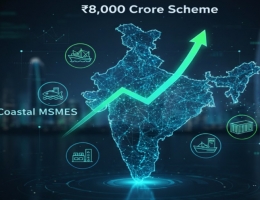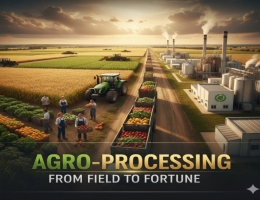
Poultry and Meat Processing: Unlocking a New Growth Avenue for India’s MSMEs
India’s poultry and meat processing sector is fast emerging as a critical pillar of the country’s agribusiness transformation. Rising incomes, urbanisation, and changing dietary preferences are driving strong demand for protein-rich foods, hygienically processed meat, and convenient value-added products. For micro, small and medium enterprises (MSMEs), this shift represents a powerful opportunity to move beyond primary production into organised, technology-driven processing and export. As one industry expert aptly noted, “India’s poultry and meat sector is no longer about farming alone , it is about creating safe, traceable, value-added food for the world.”
Government support for this transformation is expanding rapidly. The Animal Husbandry Infrastructure Development Fund (AHIDF), launched under the Atmanirbhar Bharat Abhiyan, provides capital subsidies, 3% interest subvention, and credit guarantees for projects in poultry, meat processing, feed, and cold-chain infrastructure (dahd.nic.in ). This focus on value-chain development has made the sector a key growth driver for rural and semi-urban MSMEs. Beyond domestic consumption, India’s export potential , particularly for processed poultry and buffalo meat, continues to grow under the guidance of the Agricultural and Processed Food Products Export Development Authority (APEDA)(apeda.gov.in ).
Building a Poultry and Meat Processing Enterprise: Key Considerations for MSMEs
Entering this industry begins with identifying the right niche and value-chain segment. Entrepreneurs may choose to operate hatcheries, poultry farms, slaughtering and processing units, feed mills, or value-added food production facilities such as ready-to-cook or frozen meat products. The choice should align with local resource availability, consumer demand, and infrastructure access. Formalisation is the next critical step; MSMEs must register on the Udyam Registration Portal (udyamregistration.gov.in) to access government credit, market support, and performance-linked schemes.
Compliance with food safety and hygiene norms is essential. All processing units must obtain licenses under the Food Safety and Standards Authority of India (FSSAI) (fssai.gov.in ) and follow scientific slaughtering, packaging, and labeling standards. Adopting Good Manufacturing Practices (GMP) and Hazard Analysis and Critical Control Points (HACCP) frameworks enhances quality assurance and export readiness. MSMEs can also utilise technical assistance from the National Research Centre on Meat (NRCM) (icar.org.in ) to modernise their facilities and adopt efficient processing technologies.
Financial support for setting up or upgrading units is available through multiple schemes. The Pradhan Mantri Kisan SAMPADA Yojana (PMKSY) and PM Formalisation of Micro Food Processing Enterprises (PMFME) Scheme (mofpi.gov.in ) provide grants for establishing processing and cold-chain infrastructure. Similarly, the National Livestock Mission (NLM) (dahd.nic.in ) offers up to 50?pital subsidy for poultry breeding, hatcheries, and feed units. MSMEs can also access collateral-free loans through the Credit Guarantee Fund Trust for Micro and Small Enterprises (CGTMSE) (dcmsme.gov.in).
Technology adoption and sustainability are now central to competitiveness. Modern environment-controlled sheds, energy-efficient chilling systems, and waste-to-energy conversion not only reduce costs but also align with India’s broader sustainability goals. Branding, traceability, and digital marketing further enhance credibility. Through the Digital MSME Scheme (dcmsme.gov.in), small enterprises can integrate ICT tools for farm-to-fork traceability, e-commerce sales, and enterprise management.
The Road Ahead: From Farms to Global Markets
The future of India’s poultry and meat processing ecosystem lies in scale, quality, and export-orientation. With schemes like AHIDF and PMFME driving formalisation and technology adoption, MSMEs can evolve into organised, competitive players capable of meeting domestic and global demand. Export potential is immense, India already ranks among the top meat exporters, and with enhanced value addition and hygiene standards, MSMEs can tap premium markets in the Middle East, Southeast Asia, and Africa. To sustain this momentum, enterprises must prioritise cold-chain logistics, skilled manpower, and scientific production methods. As one MoFPI official highlighted, “The vision is to turn every rural producer into a value creator through modern processing and branding.” With continued government support and growing consumer demand, the poultry and meat processing sector could become one of the largest contributors to India’s rural industrialisation and employment generation.
For India’s MSMEs, this is more than a business opportunity, it is a pathway to transform traditional livestock rearing into a modern, export-driven, and sustainable economic engine, fully aligned with the vision of Atmanirbhar Bharat.











